torque JEEP RENEGADE 2018 Owner handbook (in English)
[x] Cancel search | Manufacturer: JEEP, Model Year: 2018, Model line: RENEGADE, Model: JEEP RENEGADE 2018Pages: 356, PDF Size: 6.11 MB
Page 101 of 356
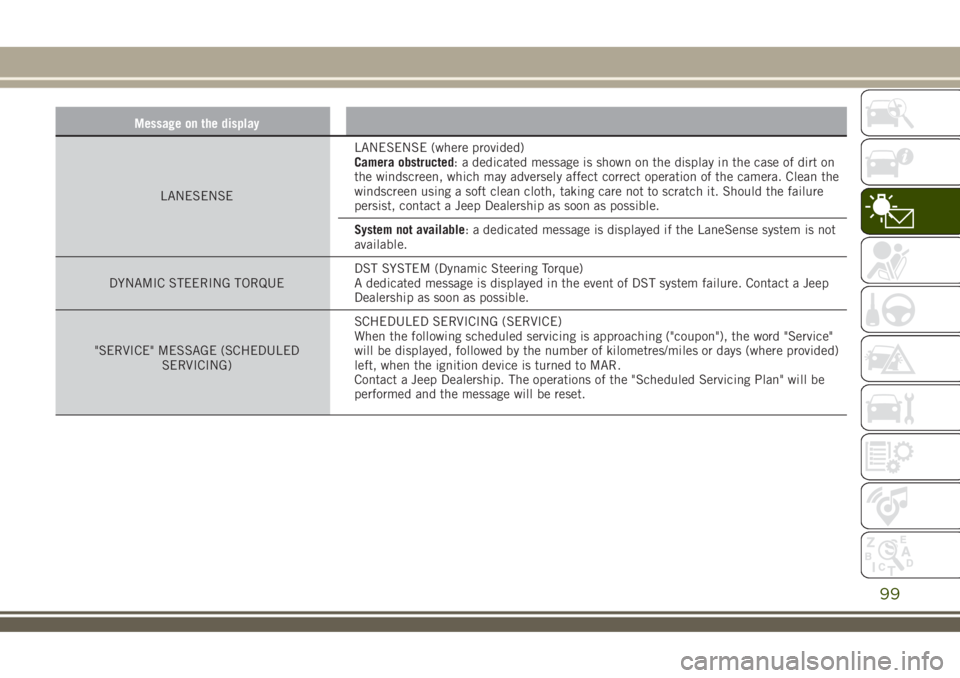
Message on the display
LANESENSELANESENSE (where provided)
Camera obstructed: a dedicated message is shown on the display in the case of dirt on
the windscreen, which may adversely affect correct operation of the camera. Clean the
windscreen using a soft clean cloth, taking care not to scratch it. Should the failure
persist, contact a Jeep Dealership as soon as possible.
System not available: a dedicated message is displayed if the LaneSense system is not
available.
DYNAMIC STEERING TORQUEDST SYSTEM (Dynamic Steering Torque)
A dedicated message is displayed in the event of DST system failure. Contact a Jeep
Dealership as soon as possible.
"SERVICE" MESSAGE (SCHEDULED
SERVICING)SCHEDULED SERVICING (SERVICE)
When the following scheduled servicing is approaching ("coupon"), the word "Service"
will be displayed, followed by the number of kilometres/miles or days (where provided)
left, when the ignition device is turned to MAR.
Contact a Jeep Dealership. The operations of the "Scheduled Servicing Plan" will be
performed and the message will be reset.
99
Page 104 of 356
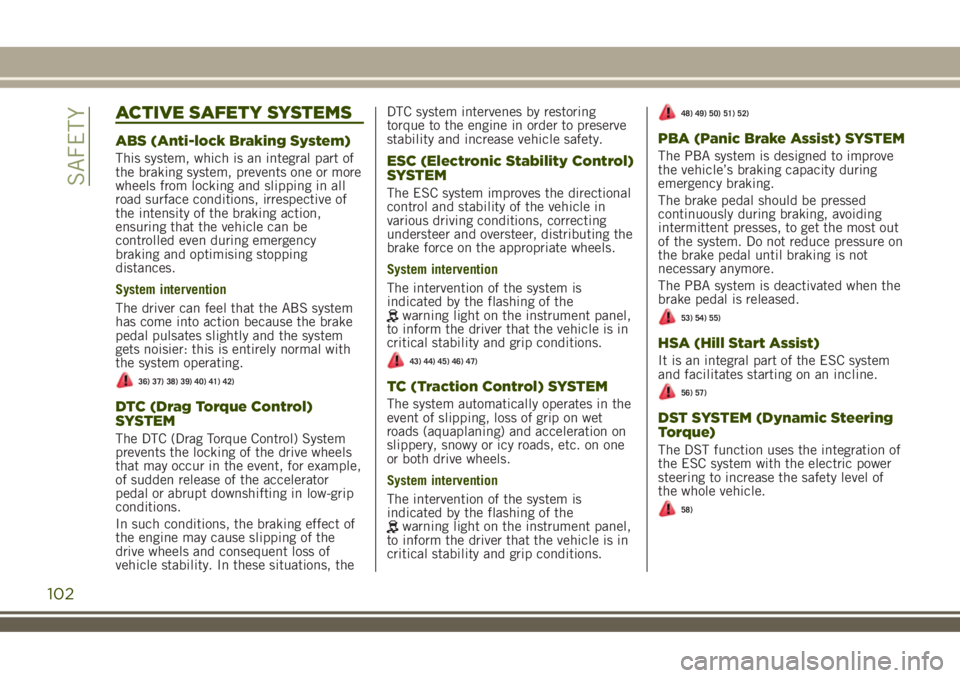
ACTIVE SAFETY SYSTEMS
ABS (Anti-lock Braking System)
This system, which is an integral part of
the braking system, prevents one or more
wheels from locking and slipping in all
road surface conditions, irrespective of
the intensity of the braking action,
ensuring that the vehicle can be
controlled even during emergency
braking and optimising stopping
distances.
System intervention
The driver can feel that the ABS system
has come into action because the brake
pedal pulsates slightly and the system
gets noisier: this is entirely normal with
the system operating.
36) 37) 38) 39) 40) 41) 42)
DTC (Drag Torque Control)
SYSTEM
The DTC (Drag Torque Control) System
prevents the locking of the drive wheels
that may occur in the event, for example,
of sudden release of the accelerator
pedal or abrupt downshifting in low-grip
conditions.
In such conditions, the braking effect of
the engine may cause slipping of the
drive wheels and consequent loss of
vehicle stability. In these situations, theDTC system intervenes by restoring
torque to the engine in order to preserve
stability and increase vehicle safety.
ESC (Electronic Stability Control)
SYSTEM
The ESC system improves the directional
control and stability of the vehicle in
various driving conditions, correcting
understeer and oversteer, distributing the
brake force on the appropriate wheels.
System intervention
The intervention of the system is
indicated by the flashing of the
warning light on the instrument panel,
to inform the driver that the vehicle is in
critical stability and grip conditions.
43) 44) 45) 46) 47)
TC (Traction Control) SYSTEM
The system automatically operates in the
event of slipping, loss of grip on wet
roads (aquaplaning) and acceleration on
slippery, snowy or icy roads, etc. on one
or both drive wheels.
System intervention
The intervention of the system is
indicated by the flashing of the
warning light on the instrument panel,
to inform the driver that the vehicle is in
critical stability and grip conditions.
48) 49) 50) 51) 52)
PBA (Panic Brake Assist) SYSTEM
The PBA system is designed to improve
the vehicle’s braking capacity during
emergency braking.
The brake pedal should be pressed
continuously during braking, avoiding
intermittent presses, to get the most out
of the system. Do not reduce pressure on
the brake pedal until braking is not
necessary anymore.
The PBA system is deactivated when the
brake pedal is released.
53) 54) 55)
HSA (Hill Start Assist)
It is an integral part of the ESC system
and facilitates starting on an incline.
56) 57)
DST SYSTEM (Dynamic Steering
Torque)
The DST function uses the integration of
the ESC system with the electric power
steering to increase the safety level of
the whole vehicle.
58)
102
SAFETY
Page 109 of 356

60)When towing trailers, the utmost
caution at the wheel is recommended.
Never exceed the maximum permitted
loads (see the description in the "Weights"
paragraph in the "Technical
Specifications" chapter).
61)The TSC system cannot prevent
swerving for all trailers. If the system
activates during driving, reduce the speed,
stop the vehicle in a safe place and
arrange the load correctly to prevent the
trailer from swerving.
62)Prolonged use of the system may
overheat the braking system. If the brakes
overheat, the HDC system, when active,
will be gradually deactivated after suitably
informing the driver (LED on button off): it
can be reactivated only when the brakes
have cooled sufficiently. The distance that
can be covered depends on the
temperature of the brakes and therefore
on the gradient, load and speed of the
vehicle.
63)The performance of a vehicle with
HDC must never be tested in imprudent or
dangerous ways, with the possibility of
putting the safety of the driver or other
people at risk.64)When "Systems partially disabled"
mode is selected, the intervention of the
TC function is limited to braking action on
the individual drive wheels and the
warning light switches on in the
instrument panel. In "systems partially
disabled" mode, the engine torque value
that the ESC system may require will not
be guaranteed and the stability of the
vehicle will therefore be reduced.
65)With "Systems partially disabled"
mode selected, the TSC (Trailer Sway
Control) system is disabled.
66)Your driving style must always be
suited to the road conditions, visibility and
traffic. The driver is, in any case,
responsible for safe driving.
67)When "Systems disabled" mode is
selected, the ESC system will not be
available in the event of emergency
manoeuvres. "Systems disabled" mode is
only for off-road use.
107
Page 157 of 356

available and restart the engine, using
the gear lever as described previously.
MOVING THE CAR
To move the car, from P press the brake
pedal and, using the button on the gear
lever, move the lever to the desired
position (D, R or "Sequential mode"). The
display will show the gear engaged.
When the brake pedal is released, the car
starts moving forwards or backwards, as
soon as the manoeuvre is activated
("creeping" effect). The accelerator
should not be pressed in this case.
IMPORTANT The inconsistency
between the speed actually engaged
(shown on the display) and the
position of the gear lever is indicated
by the letter corresponding to the
position of the lever flashing on the
trim (also accompanied by an acoustic
signal).
This condition should not be interpreted
as an operational fault, but simply as a
request by the system to repeat the
manoeuvre.
IMPORTANT With engine running and
car stationary, in "Sequential mode",
the request for engaging 2
ndgear is
not accepted by the system (whether
the brake pedal is pressed or not).
If, with 1stgear or reverse (R) engaged,
the following conditions occur:
road slope over 5%;clutch overheated;engine torque constant for a given
period (e.g. if the car hits the pavement
or is parked downhill/uphill);
car movement is achieved by pressing
the accelerator pedal.
IMPORTANT With the electric parking
brake released and brake pedal
released, engine at idling speed and
gear lever in position D, R or
sequential, pay the utmost care
because the car can move even
without the operation of the
accelerator pedal. This condition can
be used with the car on a level surface
during tight parking manoeuvres using
the brake pedal only.
VEHICLE SHUTDOWN
Versions equipped with a Keyless Go
system: shift the gear lever to P (Park)
before shutting down the vehicle by
pressing the button next to the steering
wheel (see fig. 108 ).Versions equipped with key without remote
control: shift the gear lever to P (Park)
before extracting the key from the
ignition device.
If the vehicle battery is flat and the
ignition key is engaged, the latter is
locked in position.
Versions with a Start&Stop system: in order
to switch off the engine, the vehicle
needs to be stopped by applying
appropriate pressure on the brake pedal.
If the pressure is not sufficient, the
engine will not switch off. This feature
can be exploited so that the engine does
not switch off in particular traffic
conditions.
108J0A0022C
155
Page 159 of 356
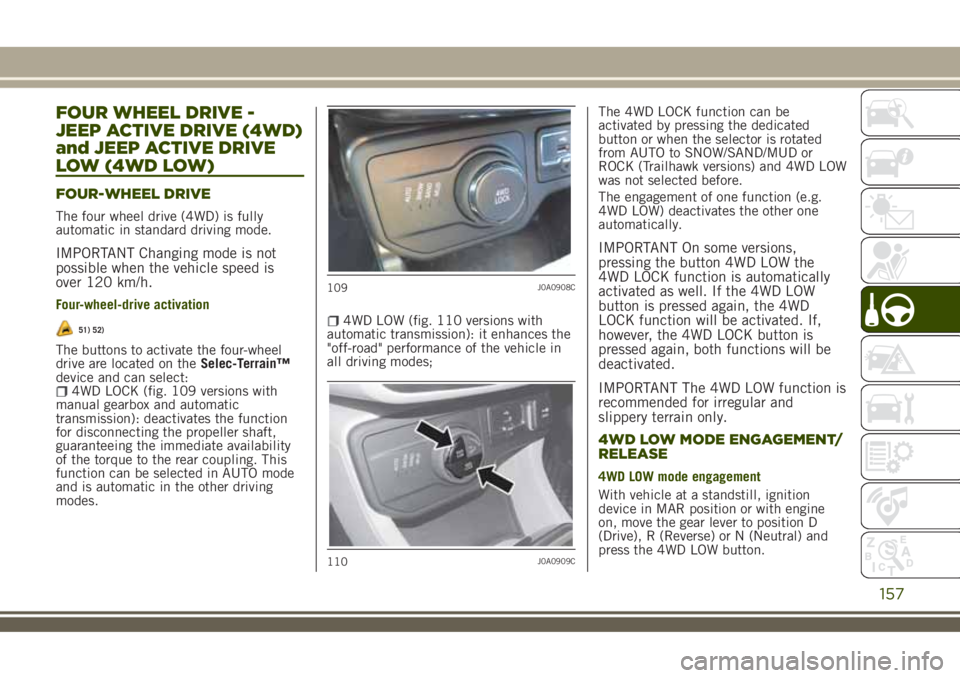
FOUR WHEEL DRIVE -
JEEP ACTIVE DRIVE (4WD)
and JEEP ACTIVE DRIVE
LOW (4WD LOW)
FOUR-WHEEL DRIVE
The four wheel drive (4WD) is fully
automatic in standard driving mode.
IMPORTANT Changing mode is not
possible when the vehicle speed is
over 120 km/h.
Four-wheel-drive activation
51) 52)
The buttons to activate the four-wheel
drive are located on theSelec-Terrain™
device and can select:
4WD LOCK (fig. 109 versions with
manual gearbox and automatic
transmission): deactivates the function
for disconnecting the propeller shaft,
guaranteeing the immediate availability
of the torque to the rear coupling. This
function can be selected in AUTO mode
and is automatic in the other driving
modes.
4WD LOW (fig. 110 versions with
automatic transmission): it enhances the
"off-road" performance of the vehicle in
all driving modes;The 4WD LOCK function can be
activated by pressing the dedicated
button or when the selector is rotated
from AUTO to SNOW/SAND/MUD or
ROCK (Trailhawk versions) and 4WD LOW
was not selected before.
The engagement of one function (e.g.
4WD LOW) deactivates the other one
automatically.
IMPORTANT On some versions,
pressing the button 4WD LOW the
4WD LOCK function is automatically
activated as well. If the 4WD LOW
button is pressed again, the 4WD
LOCK function will be activated. If,
however, the 4WD LOCK button is
pressed again, both functions will be
deactivated.
IMPORTANT The 4WD LOW function is
recommended for irregular and
slippery terrain only.
4WD LOW MODE ENGAGEMENT/
RELEASE
4WD LOW mode engagement
With vehicle at a standstill, ignition
device in MAR position or with engine
on, move the gear lever to position D
(Drive), R (Reverse) or N (Neutral) and
press the 4WD LOW button.
109J0A0908C
110J0A0909C
157
Page 180 of 356
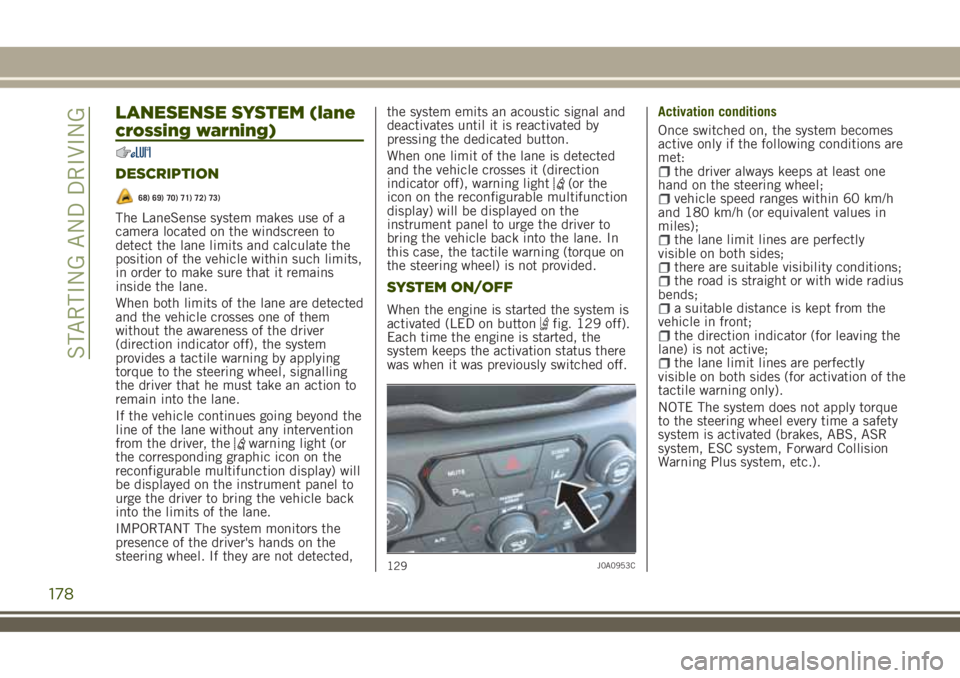
LANESENSE SYSTEM (lane
crossing warning)
DESCRIPTION
68) 69) 70) 71) 72) 73)
The LaneSense system makes use of a
camera located on the windscreen to
detect the lane limits and calculate the
position of the vehicle within such limits,
in order to make sure that it remains
inside the lane.
When both limits of the lane are detected
and the vehicle crosses one of them
without the awareness of the driver
(direction indicator off), the system
provides a tactile warning by applying
torque to the steering wheel, signalling
the driver that he must take an action to
remain into the lane.
If the vehicle continues going beyond the
line of the lane without any intervention
from the driver, the
warning light (or
the corresponding graphic icon on the
reconfigurable multifunction display) will
be displayed on the instrument panel to
urge the driver to bring the vehicle back
into the limits of the lane.
IMPORTANT The system monitors the
presence of the driver's hands on the
steering wheel. If they are not detected,the system emits an acoustic signal and
deactivates until it is reactivated by
pressing the dedicated button.
When one limit of the lane is detected
and the vehicle crosses it (direction
indicator off), warning light
(or the
icon on the reconfigurable multifunction
display) will be displayed on the
instrument panel to urge the driver to
bring the vehicle back into the lane. In
this case, the tactile warning (torque on
the steering wheel) is not provided.
SYSTEM ON/OFF
When the engine is started the system is
activated (LED on buttonfig. 129 off).
Each time the engine is started, the
system keeps the activation status there
was when it was previously switched off.Activation conditions
Once switched on, the system becomes
active only if the following conditions are
met:
the driver always keeps at least one
hand on the steering wheel;
vehicle speed ranges within 60 km/h
and 180 km/h (or equivalent values in
miles);
the lane limit lines are perfectly
visible on both sides;
there are suitable visibility conditions;the road is straight or with wide radius
bends;
a suitable distance is kept from the
vehicle in front;
the direction indicator (for leaving the
lane) is not active;
the lane limit lines are perfectly
visible on both sides (for activation of the
tactile warning only).
NOTE The system does not apply torque
to the steering wheel every time a safety
system is activated (brakes, ABS, ASR
system, ESC system, Forward Collision
Warning Plus system, etc.).
129J0A0953C
178
STARTING AND DRIVING
Page 214 of 356
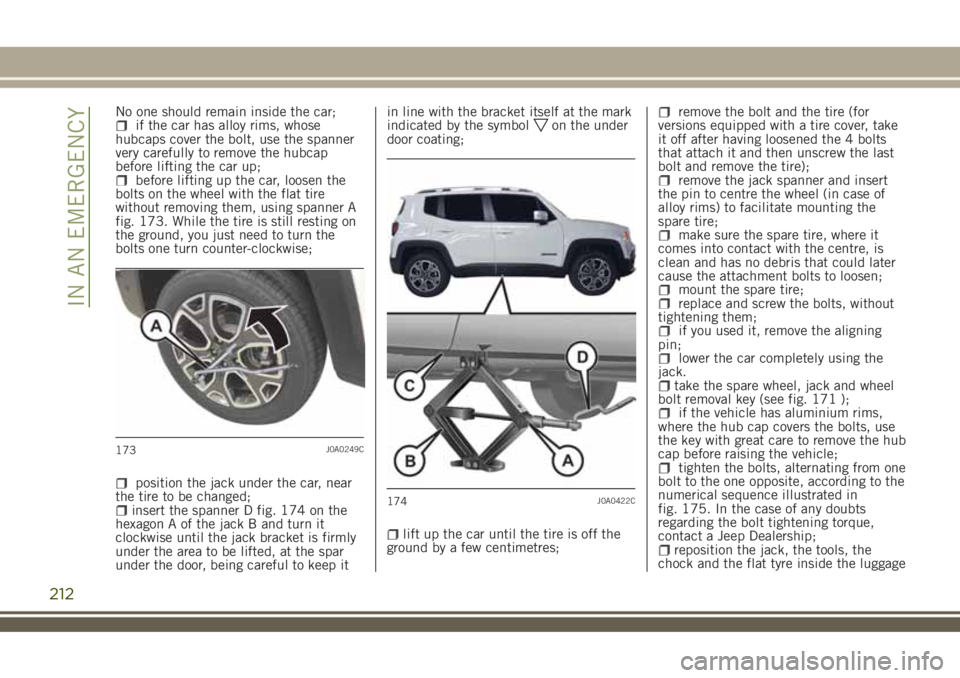
No one should remain inside the car;if the car has alloy rims, whose
hubcaps cover the bolt, use the spanner
very carefully to remove the hubcap
before lifting the car up;
before lifting up the car, loosen the
bolts on the wheel with the flat tire
without removing them, using spanner A
fig. 173. While the tire is still resting on
the ground, you just need to turn the
bolts one turn counter-clockwise;
position the jack under the car, near
the tire to be changed;
insert the spanner D fig. 174 on the
hexagon A of the jack B and turn it
clockwise until the jack bracket is firmly
under the area to be lifted, at the spar
under the door, being careful to keep itin line with the bracket itself at the mark
indicated by the symbol
on the under
door coating;
lift up the car until the tire is off the
ground by a few centimetres;
remove the bolt and the tire (for
versions equipped with a tire cover, take
it off after having loosened the 4 bolts
that attach it and then unscrew the last
bolt and remove the tire);
remove the jack spanner and insert
the pin to centre the wheel (in case of
alloy rims) to facilitate mounting the
spare tire;
make sure the spare tire, where it
comes into contact with the centre, is
clean and has no debris that could later
cause the attachment bolts to loosen;
mount the spare tire;replace and screw the bolts, without
tightening them;
if you used it, remove the aligning
pin;
lower the car completely using the
jack.
take the spare wheel, jack and wheel
bolt removal key (see fig. 171 );
if the vehicle has aluminium rims,
where the hub cap covers the bolts, use
the key with great care to remove the hub
cap before raising the vehicle;
tighten the bolts, alternating from one
bolt to the one opposite, according to the
numerical sequence illustrated in
fig. 175. In the case of any doubts
regarding the bolt tightening torque,
contact a Jeep Dealership;
reposition the jack, the tools, the
chock and the flat tyre inside the luggage
173J0A0249C
174J0A0422C
212
IN AN EMERGENCY
Page 264 of 356
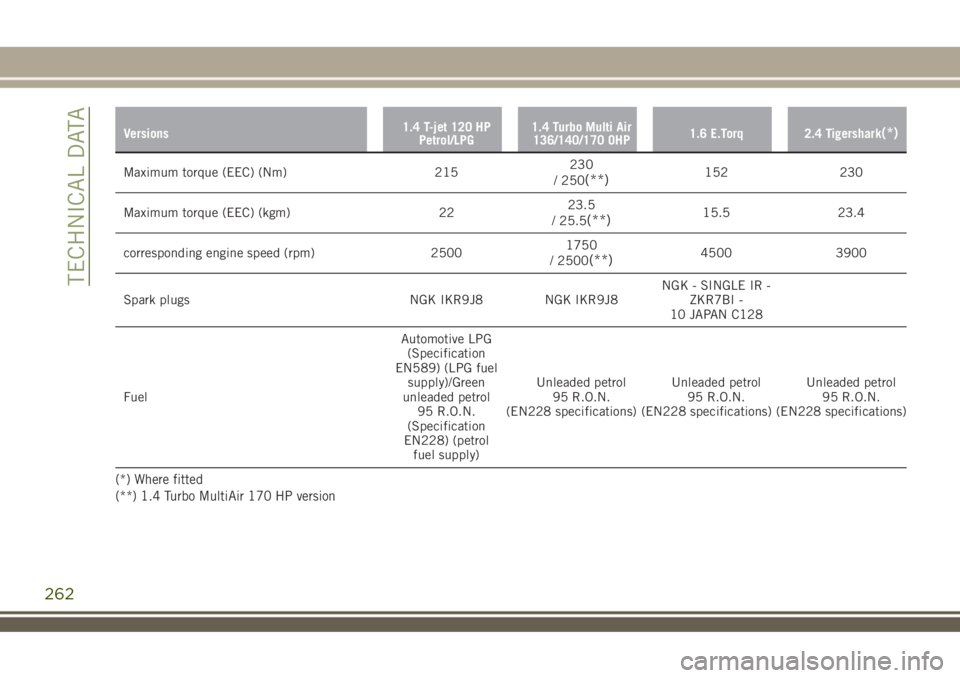
Versions1.4 T-jet 120 HP
Petrol/LPG1.4 Turbo Multi Air
136/140/170 OHP1.6 E.Torq 2.4 Tigershark(*)
Maximum torque (EEC) (Nm) 215230
/ 250(**)152 230
Maximum torque (EEC) (kgm) 2223.5
/ 25.5
(**)15.5 23.4
corresponding engine speed (rpm) 25001750
/ 2500
(**)4500 3900
Spark plugs NGK IKR9J8 NGK IKR9J8NGK - SINGLE IR -
ZKR7BI -
10 JAPAN C128
FuelAutomotive LPG
(Specification
EN589) (LPG fuel
supply)/Green
unleaded petrol
95 R.O.N.
(Specification
EN228) (petrol
fuel supply)Unleaded petrol
95 R.O.N.
(EN228 specifications)Unleaded petrol
95 R.O.N.
(EN228 specifications)Unleaded petrol
95 R.O.N.
(EN228 specifications)
(*) Where fitted
(**) 1.4 Turbo MultiAir 170 HP version
262
TECHNICAL DATA
Page 265 of 356
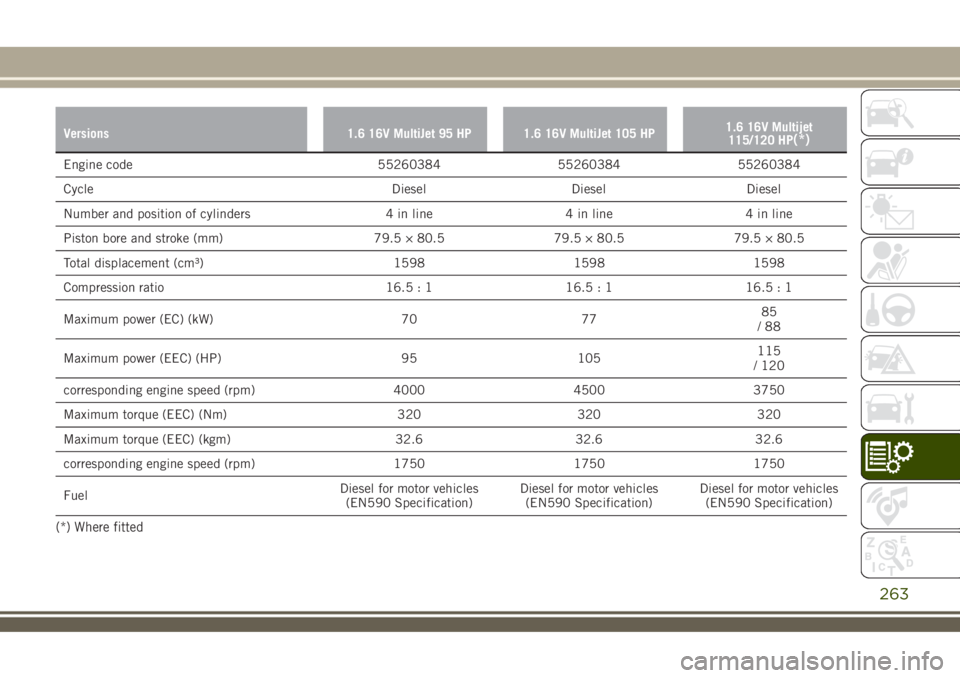
Versions 1.6 16V MultiJet 95 HP 1.6 16V MultiJet 105 HP1.6 16V Multijet
115/120 HP(*)
Engine code 55260384 55260384 55260384
Cycle Diesel Diesel Diesel
Number and position of cylinders 4 in line 4 in line 4 in line
Piston bore and stroke (mm) 79.5 × 80.5 79.5 × 80.5 79.5 × 80.5
Total displacement (cm³) 1598 1598 1598
Compression ratio 16.5 : 1 16.5 : 1 16.5 : 1
Maximum power (EC) (kW) 70 7785
/88
Maximum power (EEC) (HP) 95 105115
/ 120
corresponding engine speed (rpm) 4000 4500 3750
Maximum torque (EEC) (Nm) 320 320 320
Maximum torque (EEC) (kgm) 32.6 32.6 32.6
corresponding engine speed (rpm) 1750 1750 1750
FuelDiesel for motor vehicles
(EN590 Specification)Diesel for motor vehicles
(EN590 Specification)Diesel for motor vehicles
(EN590 Specification)
(*) Where fitted
263
Page 266 of 356

Versions 2.0 16V Multijet 120 HP 2.0 16V Multijet 140 HP 2.0 16V Multijet 170 HP
Engine code 5526308755263087 / 55263088(*)55263088
Cycle Diesel Diesel Diesel
Number and position of cylinders 4 in line 4 in line 4 in line
Piston bore and stroke (mm) 83 × 90.4 83 × 90.4 83 × 90.4
Total displacement (cm³) 1956 1956 1956
Compression ratio 16.5 16.5 16.5
Maximum power (EC) (kW) 88 103 125
Maximum power (EEC) (HP) 120 140 170
corresponding engine speed (rpm) 4000
3750 / 4000
(*)3750
Maximum torque (EC) (Nm) 320 350 350
Maximum torque (EC) (kgm) 32.6 35.7 35.7
corresponding engine speed (rpm) 1250
1500 / 1750
(*)1750
FuelDiesel for motor vehicles
(EN590 Specification)Diesel for motor vehicles
(EN590 Specification)Diesel for motor vehicles
(EN590 Specification)
(*) Versions with automatic transmission
264
TECHNICAL DATA